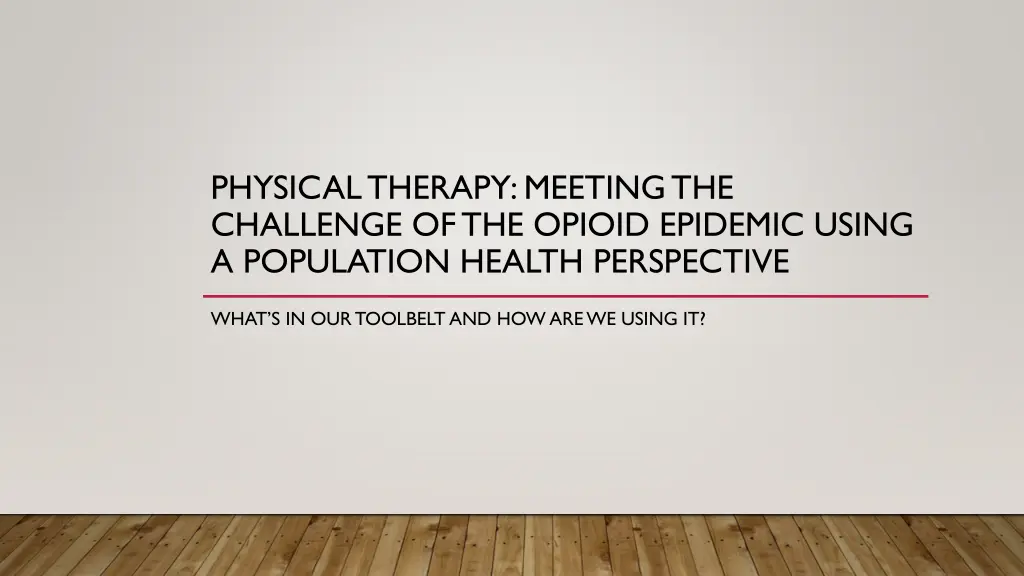
Physical Therapy's Role in Addressing the Opioid Epidemic
Explore how physical therapy can help tackle the opioid epidemic using a population health perspective. Discover the tools and strategies available to physical therapists in managing chronic pain, reducing opioid prescriptions, and improving patient outcomes.
Download Presentation

Please find below an Image/Link to download the presentation.
The content on the website is provided AS IS for your information and personal use only. It may not be sold, licensed, or shared on other websites without obtaining consent from the author. If you encounter any issues during the download, it is possible that the publisher has removed the file from their server.
You are allowed to download the files provided on this website for personal or commercial use, subject to the condition that they are used lawfully. All files are the property of their respective owners.
The content on the website is provided AS IS for your information and personal use only. It may not be sold, licensed, or shared on other websites without obtaining consent from the author.
E N D
Presentation Transcript
PHYSICAL THERAPY: MEETING THE CHALLENGE OF THE OPIOID EPIDEMIC USING A POPULATION HEALTH PERSPECTIVE WHAT S IN OUR TOOLBELT AND HOW ARE WE USING IT?
BETH GENDAY PT, MHS Bachelors in Nutrition and Bachelors and Masters in Physical Therapy Course Instructor Trauma Sensitive Care https://aptapelvichealth.org/course/rtcp/ Speaker Indiana Coalition for Ending Sexual Assault and Human Trafficking 33 years of thoughts, very few initials
PHYSICAL THERAPIST WHEN THEY HAVE YET ANOTHER PATIENT WITH CHRONIC PAIN .specific deficiencies in orthopedic physical therapists' knowledge of clinical pain mechanisms and management and potentially undesirable attitudes toward treating patients with chronic pain. (3)
WHY CHOOSE PT? Compared to patients who saw a PT later or never, patients who saw a PT first had lower probability of having an opioid prescription (89.4 percent), any advanced imaging services (27.9 percent), and an Emergency Department visit (14.7 percent), yet 19.3 percent higher probability of hospitalization (all p < .001). These patients also had significantly lower out-of-pocket costs, and costs appeared to shift away from outpatient and pharmacy toward provider settings. (1) Frogner et al PT intervention is a feasible approach to mitigating chronic pain and opioid use among PLH and should be implemented on a larger scale for maximal effect. (PLH = people Living with HIV) (2) Pullen et al
WHAT DOES AN OPIOID DO? Binds to the same receptors as endorphins
CHANGING OUR APPROACH AND MAXIMIZING OUR SKILL SET AND TOOL BOX What should we be doing to avoid the prescription of opioids? 1. Direct access 2. Education of patient regarding pain, swelling and the role of pain in healing rather than an alert to a problem 3. Use of manual, exercise prescription and movement science to improve function early
WHAT PATIENTS THINK PAIN MEANS AND WHAT IT REALLY MEANS REALITY: A MESSAGE THAT SOMETHING IS GOING ON AND IT MAY OR MAY NOT BE SERIOUS AND MAY ACTUALLY BE TELLING YOU SOMETHING HELPFUL PATIENTS: SOMETHING POSSIBLY CATASTROPHIC THAT COULD CHALLENGE QOL
ACUTE TO SUBACUTE PATIENT ON OPIOIDS AND/OR WEANING OFF As the body accommodates to the opioid or is weaning off, increased anxiety and reactivity to pain, increased HRV (Heart Rate variability) Education of patient regarding what to expect Use of pain neuroscience Use of SNS downtraining Use of manual Therapies as well as giving patients a pain relief menu of options to try Do we see these patients more frequently to give them additional coaching, hands on skills, provide more support and be a partner in this time frame
CHRONIC PAIN PATIENTS Establishment of goals and strategies Provide a menu of pain control options that can include manual, exercise and SNS modulation activities Use of visits: see more initially and wean down as they become more independent Essential to have a community based option for DC from PT.
TAKE HOME MESSAGE: WE NEED TO ESTABLISH A PARTNERSHIP WITH PATIENTS AND RETHINK HOW WE USE VISITS, WHAT WE GIVE PATIENT AND HOW WE LEAD THEM TO LONG TERM OPTIONS
REFERENCES 1. Frogner BK, Harwood K, Andrilla CHA, Schwartz M, Pines JM. Physical Therapy as the First Point of Care to Treat Low Back Pain: An Instrumental Variables Approach to Estimate Impact on Opioid Prescription, Health Care Utilization, and Costs. Health Serv Res. 2018 Dec;53(6):4629-4646. doi: 10.1111/1475-6773.12984. Epub 2018 May 23. PMID: 29790166; PMCID: PMC6232429. 2. Pullen SD, Acker C, Kim H, Mullins M, Sims P, Strasbaugh H, Zimmerman S, Del Rio C, Marconi VC. Physical Therapy for Chronic Pain Mitigation and Opioid Use Reduction Among People Living with Human Immunodeficiency Virus in Atlanta, GA: A Descriptive Case Series. AIDS Res Hum Retroviruses. 2020 Aug;36(8):670-675. doi: 10.1089/AID.2020.0028. Epub 2020 Jun 2. PMID: 32390457; PMCID: PMC7414798.
REFERENCES 3. Wolff MS, Michel TH, Krebs DE, Watts NT. Chronic pain--assessment of orthopedic physical therapists' knowledge and attitudes. Phys Ther. 1991 Mar;71(3):207-14. doi: 10.1093/ptj/71.3.207. PMID: 2000436.






















